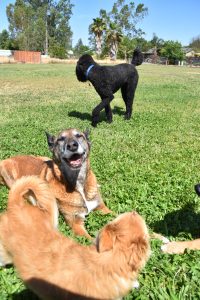 I was skeptical as I looked at the young German Shepherd tightly curled under where her owner was sitting. Here we were in the calm and tranquil space of my grassy field as I sat still and quiet trying to prove to her that I was no threat. Yet her eyes methodically scanned the environment, her rib cage heaving from the heavy breath her body was demanding to prepare her muscles for quick action from the danger that could suddenly spring from it’s hiding place and attack us. I saw a dog deeply afraid at the same time I heard her humans exclaim “she did fine” as a response when I asked about how she was in her previous, group training elsewhere. It’s a phrase that I have come to expect, examine, and unmask as a dog trainer who specializes in helping dogs with behavior problems.
I was skeptical as I looked at the young German Shepherd tightly curled under where her owner was sitting. Here we were in the calm and tranquil space of my grassy field as I sat still and quiet trying to prove to her that I was no threat. Yet her eyes methodically scanned the environment, her rib cage heaving from the heavy breath her body was demanding to prepare her muscles for quick action from the danger that could suddenly spring from it’s hiding place and attack us. I saw a dog deeply afraid at the same time I heard her humans exclaim “she did fine” as a response when I asked about how she was in her previous, group training elsewhere. It’s a phrase that I have come to expect, examine, and unmask as a dog trainer who specializes in helping dogs with behavior problems.
Along my journey in dogs I’ve come to realize that defining what fine actually means is a simple but powerful way to get to the heart of what dog training is (or what it is supposed to be, in my opinion). Through careful examination (including of myself as a dog mom,) I now understand that when we as humans describe something as “fine” in regards to our dogs, we are mostly relaying whether or not we were inconvenienced by our dog’s behavior.
I think we can do better…
Is fine really just the absence of enough fear, frustration or aggression that our dogs become uncontrollable and lash out or panic in ways that cause us to become stressed, annoyed, or embarrassed? Does the definition of fine only extend to how we as humans are experiencing things without taking into consideration the feelings of our dogs? Or can fine mean that our dogs feel safe, confident, and have the skills and relationship with us they need to effectively navigate the spaces we put them in? Fine can and should be so much more than just a term to describe how easy it was for us people to do something with our dogs.
Dogs are beings who are capable of big feelings, just like us humans. And just like us, each individual has different ways of expressing emotion and varying levels of comfort in showing what they are feeling. Even within our own species it can be difficult to decipher another’s emotional state. Don’t believe me? Walk around the supermarket and tell me just from looking, who has lost a loved one recently, who is stressed at work, who is dealing with crippling anxiety, and who is deeply depressed. A few may show their inner life externally but most don’t. The same goes for dogs. By the time we see exploding behavior problems, you can bet there were big feelings simmering just out of sight that our dogs couldn’t tell us about but that we would have labeled as “doing fine.” Dogs have a rich inner life that we can’t fully know. So the best we can do is to start re-examining what we mean by being fine and do our best to consider the whole team (dog and person) rather than just our own human point of view.
These days I often catch myself in the middle of telling someone my dog “did fine” and instead I pause, reflect and ask myself the tough questions:
How do I know she did fine? Were there any signs she felt otherwise? Was I careful to stop, check in with her and observe her communication? If I was able to ask her how she did, would she agree that she was “fine?” Am I making sure that I include her mental well being as part of my definition of fine?
These are the conversations I love sharing with my team of dedicated trainers and the incredible and loving dog owners we get the opportunity to work with. Helping people and their dogs actually achieve “being fine” is the most rewarding part of my job and is the goal of all dog training here at Tug Dogs.
